Shrubs and Hedges are a marvelous way to accent any home., however; overgrown hedges and bushes can keep well-kept lawns from looking their best. Hedge trimming is almost always best done during spring, although a couple of hedge variations might withstand cold and frost, but most will react poorly to having new cuts exposed to low temperatures. Not pruning properly can stunt the growth of and even kill shrubs.
Shaping and trimming keeps the plant healthy by removing dead or dying branches. This allows more sunlight and water to get to the healthy parts. Furthermore, hedges and bushes which are not properly pruned are more likely to have overgrown root systems. This can cause nearby plants and shrubs to not get the nutrients they need.
When shrubs are well-kept, they look more natural against a home than being overgrown. They also develop a more compact structure, making them look much lusher than if left unattended.
It is important to trim shrubs near the entry of the house to prevent windows from becoming obscured, which can present a security risk, enabling burglars to get closer to your home undetected.
If you plan to DIY your own, here are a few trimming tips:
- When to trim – During summer you can fine-trim as much as you want, periodically snipping outgrowth during the growing cycle will encourage growth and make it branch upwards. If needed, do two major trims – one in the middle of summer and the other towards the end.
- Tools – Be careful when choosing what tools you use. Cheap tools often lose their edge fast and a dull blade can do more damage than good by squeezing while cutting, thus getting in the way of the healthy re-growth. To achieve the best result use hand pruners for the majority of the fine work, hedge shears with serrated blades for heavier branches and lopping shears for the thickest ones.
- How to do it – To trim your hedges into an even, beautiful shape, you might want to use strings (or a measure laser) as guidelines. First you get rid of main offenders – large branches sticking out, then get down to the fine pruning. Hedge sides should be trimmed wider at the base to provide maximum light and sun for the exposed leaves. The hedge should resemble a vase turned upside-down.
- So, what has to go? If you’re trimming it down for re-growth you can focus on long branches in the middle; whereas, if you’re ”fine-tuning”, you can concentrate on shape, evenness and thinning out. Start from the top and work your way downward. Also remember to fertilize the hedge to give it energy and to stimulate further growth.



